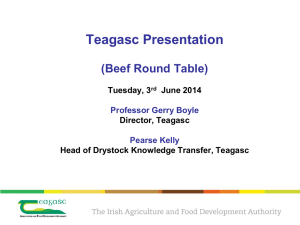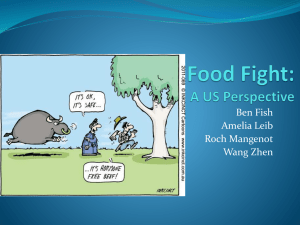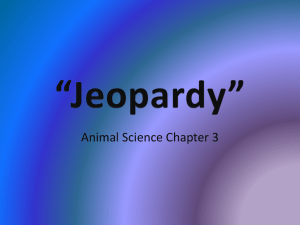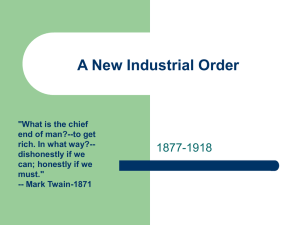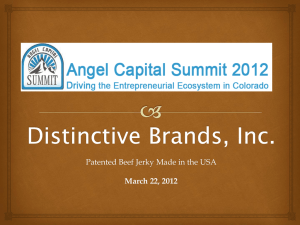Teagasc Presentation
advertisement
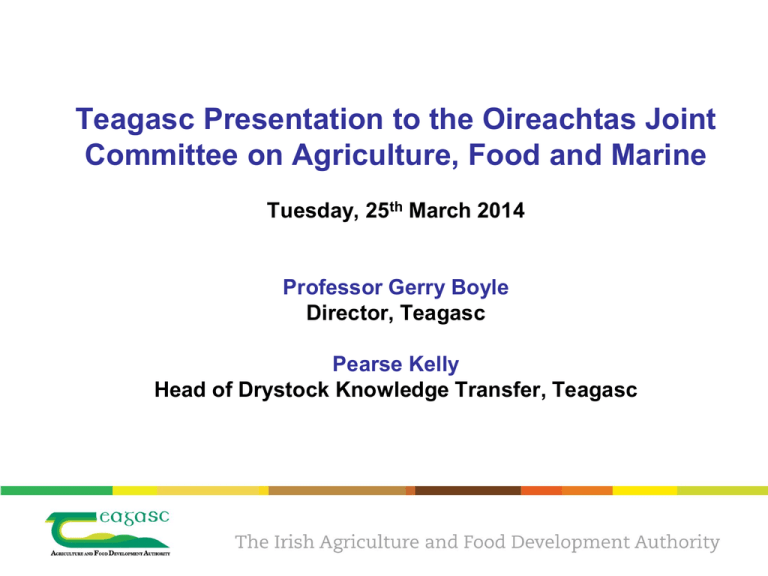
Teagasc Presentation to the Oireachtas Joint Committee on Agriculture, Food and Marine Tuesday, 25th March 2014 Professor Gerry Boyle Director, Teagasc Pearse Kelly Head of Drystock Knowledge Transfer, Teagasc Outline • Teagasc’s role – to provide knowledge and information for decision making • Bulls vs. steers – from 5-year price premium to price penalty … huge adverse impact on profitability • The efficiency advantages of bulls beef vs. steers • Teagasc research on bull beef • Motivation for Teagasc research on bull beef • Traditional Teagasc advice on bull beef production • Post crisis Teagasc advice for beef producers • Summary Bull vs. steer prices – dramatic reversal of price differential Cent per kg deadweight (excl. VAT) Year Young Bulls (O3) Steers (O3) Young Bulls (R3) Steers (R3) 2008 308 + 2c 306 323 + 6c 317 2009 276 + 1c 275 296 + 9c 287 2010 279 + 5c 274 296 + 5c 291 2011 332 + 5c 327 347 + 3c 344 2012 372 + 3c 369 388 + 2c 386 2013 380 - 10c 390 401 - 7c 408 2014 (ytd) 323 - 43c 366 350 - 33c 383 Source: Bord Bia Website 2014 Impact of price penalty on margins Teagasc Bull Beef Budget – September 2013 420 Kg LW Bull finished over 180 days Purchased at €1,067 675 Kg LW at slaughter (>16 months) 385 Kg Carcass weight Cent/Kg carcass price required to Break Even Current Price (cent / Kg) Difference (cent / Kg) Impact per Head = - €362 464 c/Kg 370 c/Kg 94c/Kg Bulls vs. Steers – major efficiency advantages for same product price • More efficient meat producers • • 15-20% better than steers/heifers • Better carcass conformation, meat yield and lower fat • Driven by natural male hormone, testosterone Slaughtered at a younger age • • 13-18 month-bulls vs. 22-26 month-steers/heifers Lower carbon footprint But • • • • • Possible behaviour and safety issues Normally higher concentrate input Getting adequate fat at young age and lighter carcasses Possible meat quality (sensory) issues with older bulls / tightening market specifications UK Market (approx. 50% of market) is primarily a steer and heifer beef market Bull vs. steer – faster finish weights Bulls vs. steers – international efficiency evidence Teagasc Grange Data ~ +8% ADG ~ +9% Carcass weight ~ +20% Lean Meat Yield N.I. Data (/kg feed eaten) ~ +10% ADG ~ +14% Carcass weight ~ +20% Lean Meat Yield USA Data ~ +17% ADG ~ -35% Carcass Fat ~ +13% Feed Efficient Europe Data ~ +20% ADG ~ -20% Carcass Fat ~ +17% Feed Efficient Teagasc research on bull beef • Dairy bull beef research at Johnstown Castle – big increase in production of dairy bull calves • Associated dairy-bull beef research on 4 commercial demonstration farms • Long-term research on suckler bull-beef production and sensory analysis at Teagasc Grange • Recent research at Teagasc Grange (Derrypatrick Herd) • Teagasc/Irish Farmers Journal BETTER Beef Programme (commercial farms) Key findings from Teagasc dairy bull beef research Cost of Production • 16 Month Dairy Bull Beef €3.59 / Kg DW • 19 Month Dairy Bull Beef €2.73 / Kg DW • 24 Month Dairy Steer Beef €3.10 / Kg DW • 15, 19 and 22 month dairy bull beef was tested for tenderness, toughness, juiciness, crunchiness, aftertaste. • Results showed no difference in any of the eating quality measurements. Performance (€/ha) on the four demonstration farms 4000 3500 €3,777 Mostly Finishing steers €2,899 3000 €2,326 2500 2000 1749 Kg LW €1,596 1500 1586 Kg LW 1256 Kg LW 1085 Kg LW 1000 500 Gross Output per Ha. €998 €1,174 €743 Gross Margin per Ha. €305 0 2010 2011 2012 2013 Note: Average Gross Margin per ha. from 847 suckling farms in 2012 was €469 / ha. (eProfit Monitor) Key findings from long-term suckler bull-beef research at Teagasc Grange Cost of Production* • 16 Month Suckler Bull Beef €4.09 / Kg DW • 18 Month Suckler Bull Beef €3.65 / Kg DW • 24 Month Suckler Steer Beef €3.90 / Kg DW * Costs are from weanling to finish (market value of weanling reflects the cost of the suckler cow) Teagasc/Irish Farmers Journal BETTER Beef Farm Performance Gross Margin (€/ha), 2013 (n=6) (n=11) (n=6) (n=9) Teagasc research guided by its Beef Stakeholder Consultation Group • All Teagasc research and advisory programmes strive to be responsive to the industry’s needs • All Stakeholder Groups are chaired by a non-Teagasc person and are representative of all industry • The Derrypatrick Herd project, for example, was established and planned in consultation with the Teagasc Beef Stakeholder Group in 2010 • At the commencement of the project in 2010 the Stakeholder Group noted that “young bulls as bulls less than 24 months of age is a EU standard – but the market is increasing requiring that bulls are finished at younger ages (~20 months of age)”) • The Stakeholder Group opted for under 18 month bull beef as previous Grange research had shown that the financial performance per hectare was superior to under 16 month bulls and steer beef systems. • As recommended by the Stakeholder Group from 2012 onwards half of the male calves are being slaughtered as 24 month steers to compare to the bull beef system Slaughterings:bulls vs. steers % (2004 – 2013) Source: Bord Bia 2014 Traditional Teagasc advice on bull beef production • Advice has always been to talk to a meat processor before finishing cattle as bulls. • Teagasc Beef Budgets produced every September always include the following warning:“Secure market outlet required for bulls before commencing system. Some markets have upper carcass weight and age limits.” • Teagasc September 2013 Beef Newsletter (circulated to approx. 40,000 farmers) advised:“Many farmers had adopted an 18 – 20 month finish system for bulls. However, this system is coming under increasing pressure with some factories no longer accepting bulls over 16 months”. • Teagasc National Beef Conference October 2013 in Kilkenny clearly showed the economic advantage per head of steers over bulls from dairy bred male calves based on research from Johnstown Castle. Post crisis Teagasc advice for beef producers • Well grown suckler yearling bulls (450 kg+) have the potential to finish under 16 months – Talk to a processor first. • Suckler Yearling bulls > 430 kg can be finished under 18 months on dry early farms – Talk to a processor first. • Yearling Friesian bulls > 330 kg can be finished under 18 months on dry early farms – Talk to a processor first. • Under 16 month Friesian bulls at current meal and beef prices are not profitable – Only produce on contract with a processor. • Lighter weight for age bulls – option to castrate and finish as steers • Speak to your vet on best options Summary • Bull beef systems are significantly more efficient than steer beef systems and have been shown to have the potential to increase margins per hectare. • The large increase in bull beef production in recent years has been driven by the opportunity to produce higher outputs of beef per hectare especially when there was no price advantage per kg for steer beef. • Recent Teagasc research into bull beef systems has been supported and encouraged by all of the key beef industry stakeholders. • Bull beef systems that have been incorporated onto commercial demonstration farms have demonstrated high margins per hectare relative to other beef systems. • The Teagasc Derrypatrick Suckler Herd which finishes bulls was established in consultation with all the main beef industry stakeholders. • Teagasc advice has always been and continues to be that farmers who are considering finishing bulls should first establish that they have a market outlet. Thank You
